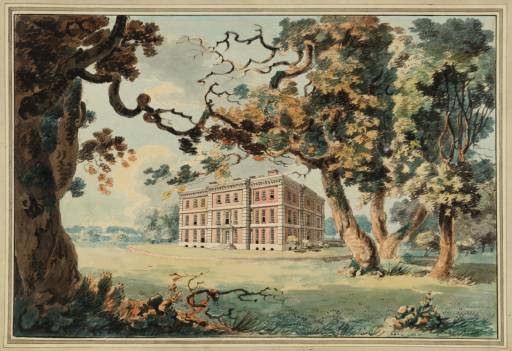Joseph Mallord William Turner Radley Hall from the South-East 1789
Joseph Mallord William Turner,
Radley Hall from the South-East
1789
Joseph Mallord William Turner 1775–1851
Radley Hall from the South-East 1789
D00049
Turner Bequest III D
Turner Bequest III D
Pencil and watercolour with pen and black and brown ink within ruled washline border, 295 x 439 mm on white wove paper, laid down, 327 x 509 mm
Inscribed by Turner in ink ‘Wm Turner pinxt’ lower right
Stamped in black ‘III D’ bottom right
Inscribed in red ink ‘III.D.’ bottom right on backing sheet
Inscribed by Turner in ink ‘Wm Turner pinxt’ lower right
Stamped in black ‘III D’ bottom right
Inscribed in red ink ‘III.D.’ bottom right on backing sheet
Accepted by the nation as part of the Turner Bequest 1856
Exhibition history
1974
Turner 1775–1851, Royal Academy, London, November 1974–March 1975 (1).
1978
¿¿¿¿¿¿ [Turner], Shipka Gallery, Sofia, Bulgaria, April–?May 1978, Belgrade, Serbia [former Yugoslavia], May 1978, Muzeul de Arte al RS [Republica Socialista] Romania, Bucharest, June–July 1978 (1, reproduced).
1988
Turner & Architecture, Tate Gallery, London, March–July 1988 (2).
References
1909
A.J. Finberg, A Complete Inventory of the Drawings of the Turner Bequest, London 1909, vol.I, p.5, III D, as ‘Radley Hall: South Front and East Side’.
1910
Alexander J. Finberg, Turner’s Sketches and Drawings, London 1910, pp.13–14, pl.III.
1961
Alexander J. Finberg, The Life of J.M.W. Turner, R.A. Second Edition, Revised, with a Supplement, by Hilda F. Finberg, revised ed., Oxford 1961, p.19.
1969
John Gage, Colour in Turner: Poetry and Truth, London 1969, p.23.
1979
Andrew Wilton, J.M.W. Turner: His Life and Work, Fribourg 1979, pp.300–1 no.8, reproduced.
1990
Joyce H. Townsend, ‘Turner’s Painting Materials: A Preliminary Discussion’, Turner Studies, vol.10 no.1, Summer 1990, p.23, fig.2, as ‘T.B. III-B’.
2005
Joyce H. Townsend, Turner’s Painting Techniques, exhibition catalogue, Tate Gallery, London 1993, 4th edition, London 2005, p.23, fig.12.
Technique and condition
This composition has been drawn in pencil and ink on white wove paper. Although the sheet is backed, in raking light the traces of the watermark are still visible in the bottom right-hand corner. The watermark reads ‘J Whatman’ and the sheet was made by J. Whatman the younger at Turkey Mill in Maidstone, Kent. It was produced using a double-faced mould. The image is on the wireside of the sheet.1
The background was drawn in pencil and the details of the house have been ruled in carefully with ink. The facing blocks of the house have been left uncoloured, whereas all other areas of the image have been painted. The windows are painted in a rather formulaic manner with an even black wash applied with ruled outlines, and they do not reflect the landscape as they would have in reality. The pink/red colour of the building is painted with a thin, even wash of vermilion, filled in right up to the inked details.
The background foliage follows the drawing exactly, and it was created using coarse flicks of paint, sometimes manipulated by the artist’s fingers. The many shades of green used in this picture are made from mixtures of a blue and a yellow pigment. The foreground foliage and the trees behind the house have a very bluish appearance which suggests fading of a yellow organic pigment from the mixture, and the most yellow-green, sunlit leaves of the large foreground tree show the effect to a lesser degree: there was more yellow in the mixture than elsewhere. Indian yellow was used, a pigment known to fade when it is exposed to light, and possibly other yellow organic yellows were also used, since the green shades are made from several different mixtures. The darker leaves are probably not altered, since their duller green tones were mixed from brown/yellow earth colours and blue.
The washed border round the work is a conventional means of presenting a finished watercolour, and it was made using ruled lines filled neatly with washes of pure earth colours or more likely mixtures of colours, to repeat the tonality of the main image, without dominating it.
Helen Evans
October 2008
Revised by Joyce Townsend
January 2011
How to cite
Helen Evans, 'Technique and Condition', October 2008, revised by Joyce Townsend, January 2011, in Andrew Wilton, ‘Radley Hall from the South-East 1789 by Joseph Mallord William Turner’, catalogue entry, April 2012, in David Blayney Brown (ed.), J.M.W. Turner: Sketchbooks, Drawings and Watercolours, Tate Research Publication, December 2012, https://wwwThis is one of two finished views of Radley Hall that have survived in the Turner Bequest; see also Tate D00048 (Turner Bequest III C). They are based on notes made in the Oxford sketchbook (Tate D00028, D00043; Turner Bequest II 14, 25a); the latter page has notes of the fenestration. As Finberg points out, this drawing demonstrates ‘the thoroughness’ of Thomas Malton’s teaching while Turner was with him.1
Turner’s washline border has been cut down at the top and bottom.
Verso:
Turner’s mount laid down on a modern sheet, stamped with Turner Bequest monogram.
Andrew Wilton
April 2012
How to cite
Andrew Wilton, ‘Radley Hall from the South-East 1789 by Joseph Mallord William Turner’, catalogue entry, April 2012, in David Blayney Brown (ed.), J.M.W. Turner: Sketchbooks, Drawings and Watercolours, Tate Research Publication, December 2012, https://www

